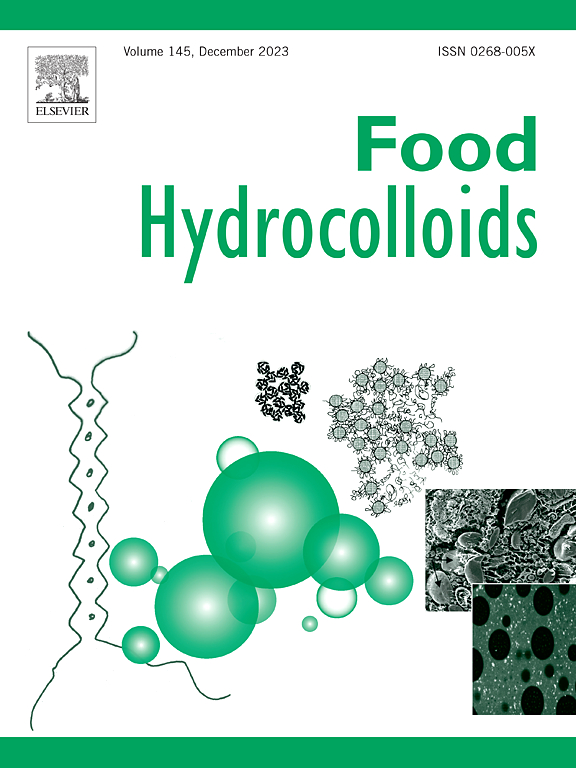Synergistic enhancement of 3D printing performance in soybean protein isolate gel inks by lonic/nonionic polysaccharides: A network rearrangement mechanism revealed by rheology and the sequence of physical processes analysis
IF 11
1区 农林科学
Q1 CHEMISTRY, APPLIED
引用次数: 0
Abstract
This study investigates the effects of guar gum (GU) and carrageenan (CA) on the printability of protein gel inks and the dynamic rearrangement of gel networks during 3D printing. Texture, microstructure, and FTIR analysis confirmed that appropriate polysaccharide concentration (0.25 %) led to higher gel strength and denser gel network because they had stronger hydrogen bonding, hydrophobic interaction, and electrostatic interaction. Rheological analysis indicated that SPI-CA gel inks exhibited superior rheological properties compared to SPI-GU gel inks at identical concentrations. LAOS test and the SPP analysis further clarified the change rule of gel network rearrangement during 3D printing. Under the condition of large amplitude, the network rearrangement of SPI-CA gel ink was slow, so it had stronger resistance to deformation. However, SPI-GU had a more flexible structure and was prone to network rearrangement in complex external environments. Therefore, SPI-CA gel ink printing products had higher self-supporting, and SPI-GU gel ink printing products had smoother surfaces and smaller graininess. Besides, LF-NMR indicated that CA was more conducive to stabilizing the moisture in the gel, and printed products printed by SPI-CA gel inks have better freeze-thaw stability than SPI-GU inks. This study provides insights into how different polysaccharides affect the rheological properties of protein-based gels and network reorganization during printing. These findings provide crucial guidance for designing complex, multi-component protein-based inks.

离子/非离子多糖对大豆分离蛋白凝胶油墨3D打印性能的协同增强:流变学和物理过程序列分析揭示的网络重排机制
本研究研究了瓜尔胶(GU)和卡拉胶(CA)对蛋白凝胶油墨可打印性的影响,以及3D打印过程中凝胶网络的动态重排。结构、微观结构和FTIR分析证实,适当的多糖浓度(0.25%)导致凝胶强度更高,凝胶网络更致密,因为它们具有更强的氢键、疏水相互作用和静电相互作用。流变学分析表明,在相同浓度下,SPI-CA凝胶墨水比SPI-GU凝胶墨水表现出更好的流变特性。老挝试验和SPP分析进一步阐明了3D打印过程中凝胶网络重排的变化规律。在大振幅条件下,SPI-CA凝胶油墨的网络重排缓慢,因此具有更强的抗变形能力。但SPI-GU具有更灵活的结构,在复杂的外部环境中容易发生网络重排。因此,SPI-CA凝胶油墨印刷产品具有更高的自支撑性,而SPI-GU凝胶油墨印刷产品表面更光滑,颗粒更小。此外,LF-NMR表明,CA更有利于稳定凝胶中的水分,SPI-CA凝胶油墨打印的打印产品比SPI-GU油墨具有更好的冻融稳定性。这项研究提供了不同的多糖如何影响蛋白基凝胶的流变特性和印刷过程中的网络重组的见解。这些发现为设计复杂的、多组分的蛋白质基油墨提供了重要的指导。
本文章由计算机程序翻译,如有差异,请以英文原文为准。
求助全文
约1分钟内获得全文
求助全文
来源期刊

Food Hydrocolloids
工程技术-食品科技
CiteScore
19.90
自引率
14.00%
发文量
871
审稿时长
37 days
期刊介绍:
Food Hydrocolloids publishes original and innovative research focused on the characterization, functional properties, and applications of hydrocolloid materials used in food products. These hydrocolloids, defined as polysaccharides and proteins of commercial importance, are added to control aspects such as texture, stability, rheology, and sensory properties. The research's primary emphasis should be on the hydrocolloids themselves, with thorough descriptions of their source, nature, and physicochemical characteristics. Manuscripts are expected to clearly outline specific aims and objectives, include a fundamental discussion of research findings at the molecular level, and address the significance of the results. Studies on hydrocolloids in complex formulations should concentrate on their overall properties and mechanisms of action, while simple formulation development studies may not be considered for publication.
The main areas of interest are:
-Chemical and physicochemical characterisation
Thermal properties including glass transitions and conformational changes-
Rheological properties including viscosity, viscoelastic properties and gelation behaviour-
The influence on organoleptic properties-
Interfacial properties including stabilisation of dispersions, emulsions and foams-
Film forming properties with application to edible films and active packaging-
Encapsulation and controlled release of active compounds-
The influence on health including their role as dietary fibre-
Manipulation of hydrocolloid structure and functionality through chemical, biochemical and physical processes-
New hydrocolloids and hydrocolloid sources of commercial potential.
The Journal also publishes Review articles that provide an overview of the latest developments in topics of specific interest to researchers in this field of activity.
 求助内容:
求助内容: 应助结果提醒方式:
应助结果提醒方式:


